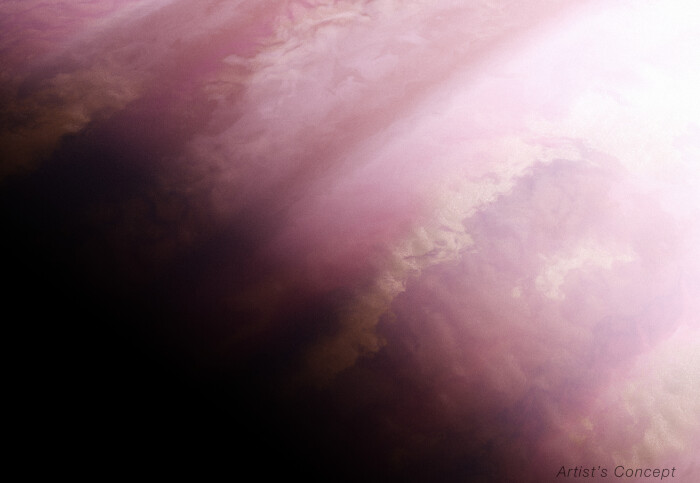‘Morning’ and ‘evening’ detected on an exoplanet

Artist's impression of the atmosphere on exoplanet WASP-39b, Credit: NASA, ESA, CSA, R. Crawford (STScI)
The different atmospheric conditions of the ‘morning’ and ‘evening’ sides of a distant planet have been revealed by the James Webb Space Telescope.
The atmospheres of exoplanets – those outside our Solar System – have been measured using powerful telescopes for some time. However, the atmosphere has always been treated as being the same all over the planet.
The new analysis, published today in Nature, focuses on a planet with an extraordinary atmosphere, revealing distinct ‘morning’ and ‘evening’ sides to the planet. The study, led by the Space Telescope Science Institute and analysed in part by an Imperial College London researcher, reveal a cloudier morning side than evening side.
There is no planet like this in our Solar System. Dr James Kirk Imperial College Research Fellow
The giant planet, named WASP-39b, has a radius larger than Jupiter, but with similar mass to Saturn and orbits a star about 700 light-years away from Earth. It’s also very close to its star, making its daily high surface temperature more than 1000°C, and meaning it completes one ‘day’ rotation in the same time it takes to complete one orbit.
This also means it is ‘tidally locked’: the same side of the planet always faces its star, in the same way the same side of the Moon always faces Earth. This creates a constant ‘day’ side and a constant ‘night’ side of the planet, but also, crucially, in between there are ‘morning’ and ‘evening’ sides.
Dr James Kirk, from the Department of Physics at Imperial College London, said: “There is no planet like this in our Solar System, but most of the planets we observe orbiting distant stars are closer, with short orbits, like WASP-39b. Now, we have been able to test our theories about these planets and, for the first time, directly measure an exoplanet’s morning and evening side over a wide wavelength range.”
Néstor Espinoza, an exoplanet researcher at the Space Telescope Science Institute and lead author on the study, commented: “This analysis is also particularly interesting because you’re getting 3D information on the planet that you weren’t getting before. Because we can tell that the evening edge is hotter, that means it’s a little puffier. So, theoretically, there is a small swell at the terminator approaching the nightside of the planet.”
Changing light
Scientists discover information about the atmospheres of exoplanets by measuring the light received as the planet passes in front of its star. As it does so, the star’s light is changed by filtering through the planet’s atmosphere. These changes are detected by instruments on the James Webb Space Telescope (JWST), with specific signatures revealing different molecules in the atmosphere.
This technique, however, assumes the atmosphere of the planet is broadly the same over its entire surface.
At WASP-39b, the day side, always facing the star, is much hotter than the night side. Because of the way the planet rotates, this huge temperature difference is thought to create a strong wind at the equator moving in one direction. This is what creates the ‘morning’ side – where cooler night wind travels into the day side; and the ‘evening’ side – where the hot day wind carries to the night side. Data reveals the evening as significantly hotter, a searing 800°C, and the morning a relatively cooler 600°C.
The way clouds form is dependent on temperature, so the team expected the morning and evening sides to have different amounts of cloud cover. They used several methods of analysing the JWST data to test this, finding that the morning was cloudier than the evening, as predicted.
Matching analyses
Dr Kirk developed one of the analysis techniques, which focused only on the light received as the planet began and ended its pass across the star’s surface. As only the edges of the planet ‘touch’ the star’s disc at these moments, the star’s light would only be filtered through the morning or evening sides of the atmosphere respectively.
The results of Dr Kirk’s analysis matched well with other analyses completed by other members of the team, which included researchers from across the United States and Europe.
The team now want to expand their analysis to include data from more instruments aboard JWST. The telescope carries instruments that can analyse light in a range of wavelengths of light – from the visible through the infrared – which could reveal more details about the atmospheric differences at WASP-39b.
Dr Kirk said: “Now we’ve demonstrated the feasibility of this method with JWST, and the precision of JWST is so immense, it really opens up a new avenue into understanding and measuring atmospheric circulation for exoplanets that we were previously largely insensitive to.”
-
'Inhomogeneous terminators on the exoplanet WASP-39b' by Néstor Espinoza et al. is published in Nature.
Article text (excluding photos or graphics) © Imperial College London.
Photos and graphics subject to third party copyright used with permission or © Imperial College London.
Reporter
Hayley Dunning
Communications Division
Corinne Farrell
Communications Division
